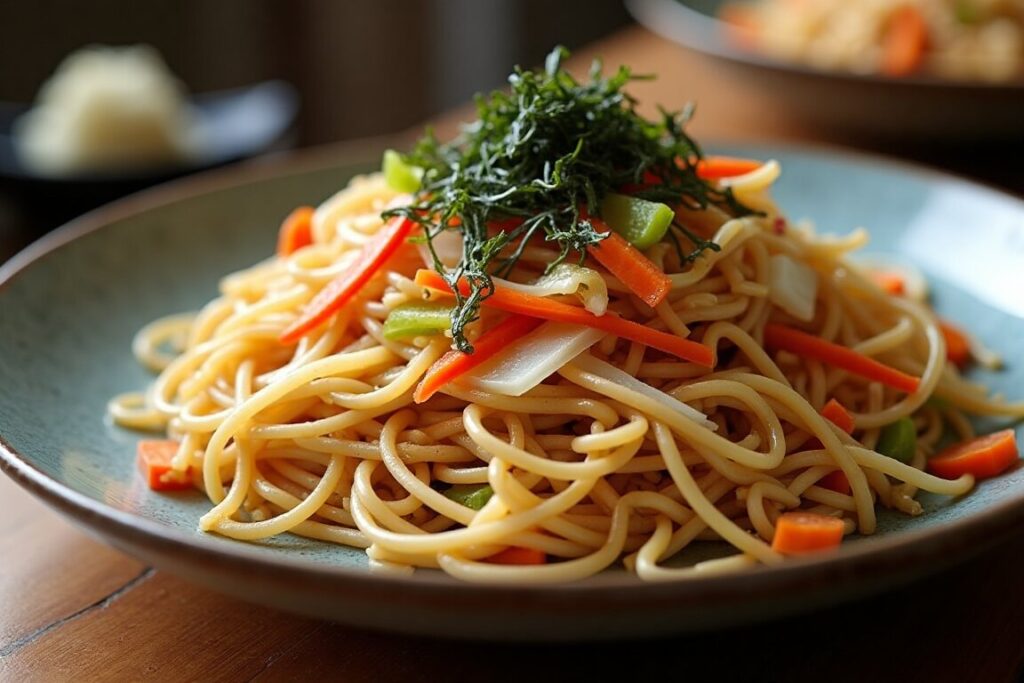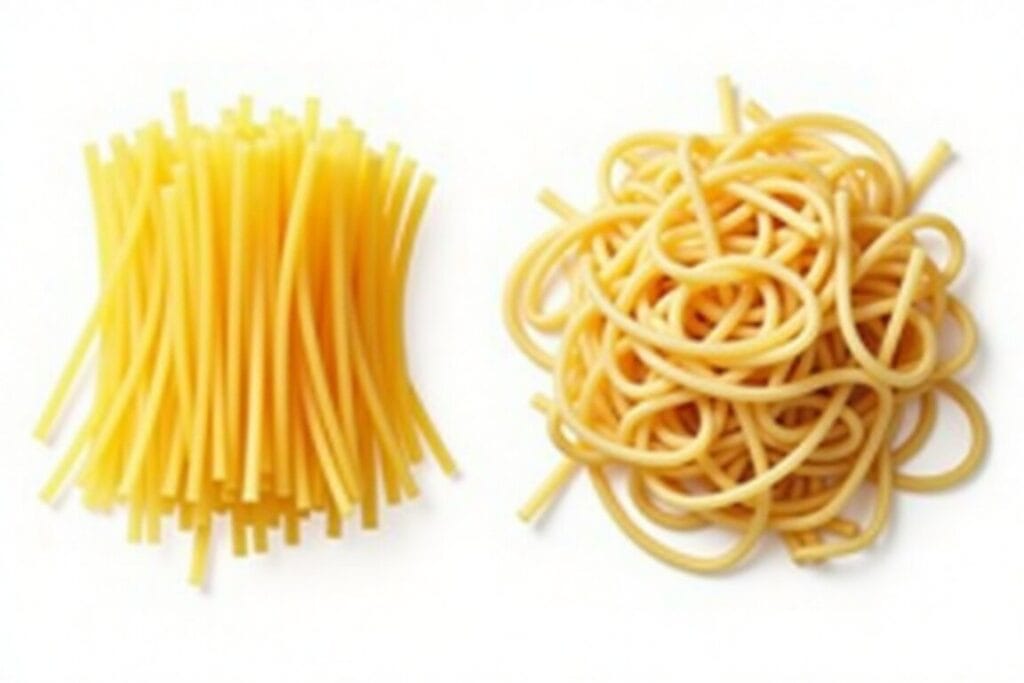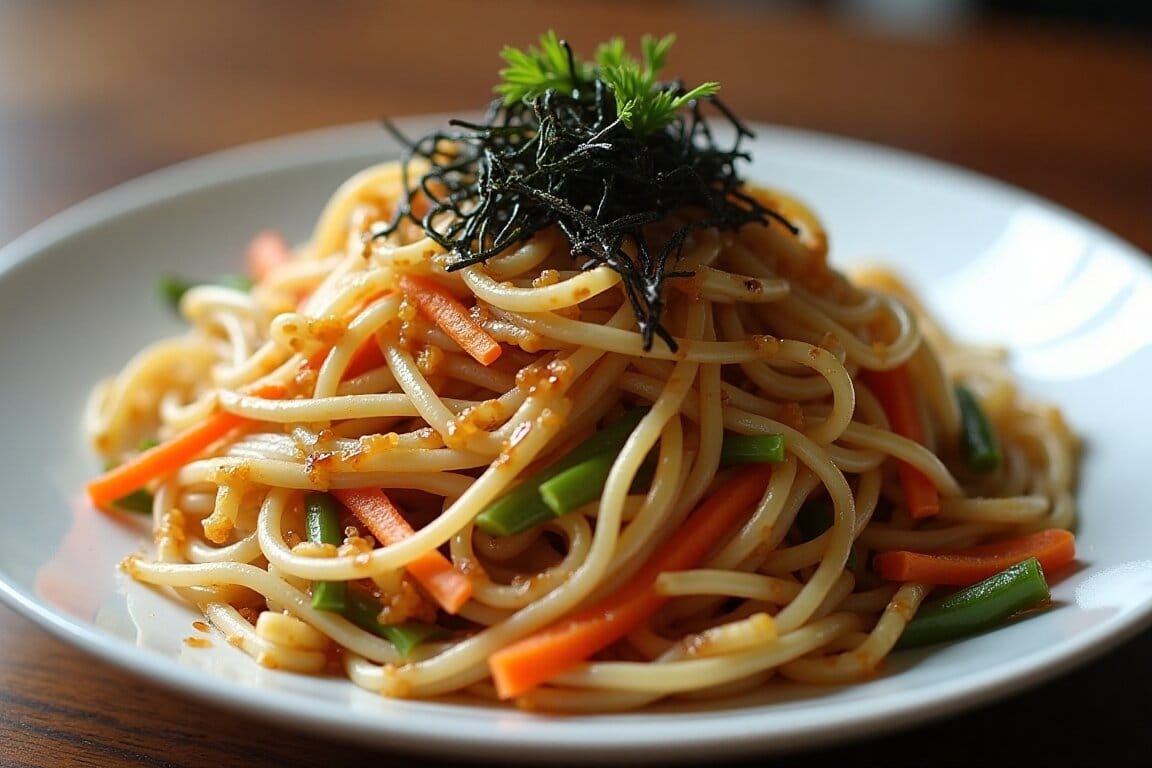Introduction
Yakisoba, a beloved Japanese dish, combines stir-fried noodles, savory sauce, fresh vegetables, and protein for a flavorful and satisfying meal. Traditionally, yakisoba is made with wheat-based noodles similar to ramen. But what happens if you can’t find authentic yakisoba noodles? Many people wonder: Can spaghetti noodles serve as a substitute?
In this article, we will explore whether spaghetti noodles can be used for yakisoba, how to adapt them to mimic traditional yakisoba noodles, and tips for achieving an authentic flavor. Whether you’re a culinary adventurer or someone seeking convenience, you’ll discover practical advice for making a delicious yakisoba-inspired dish using spaghetti.

Understanding Yakisoba
What Is Yakisoba?
Yakisoba, meaning “fried noodles,” is a popular Japanese dish with roots in Chinese cuisine. Despite its name, it does not use soba (buckwheat noodles). Instead, yakisoba typically features wheat-based noodles similar to ramen, stir-fried with vegetables and meat or seafood, and coated in a sweet and savory sauce.
This dish is a staple at festivals, street food stalls, and home kitchens throughout Japan. Its rich, umami-packed flavor and customizable ingredients make it a favorite for many.
A Brief History of Yakisoba
Yakisoba originated in Japan during the early 20th century, inspired by Chinese chow mein. The recipe evolved to suit Japanese tastes, incorporating Worcestershire-like yakisoba sauce for its signature tangy flavor. Over time, the dish became a versatile household favorite, often made with readily available ingredients.
Traditional Yakisoba Preparation
Classic yakisoba recipes involve:
- Noodles: Pre-steamed wheat noodles that are springy and chewy.
- Vegetables: Cabbage, carrots, onions, and bean sprouts.
- Protein: Pork, chicken, or tofu for vegetarians.
- Sauce: A mix of soy sauce, oyster sauce, and Worcestershire sauce for a rich glaze.
The ingredients are stir-fried together in a hot pan or wok, ensuring the noodles absorb the sauce while maintaining a slightly crisp texture.
Key Ingredients in Yakisoba
Yakisoba Sauce
The heart of yakisoba lies in its sauce, a sweet and savory blend with tangy undertones. It typically includes:
- Soy sauce for saltiness.
- Worcestershire sauce for depth.
- Sugar or mirin for sweetness.
Store-bought yakisoba sauce is convenient, but homemade versions allow you to customize the flavor profile.
Vegetables and Protein Options
Yakisoba is highly adaptable, allowing you to use seasonal or preferred vegetables and proteins. Common choices include:
- Vegetables: Shredded cabbage, julienned carrots, bell peppers, and onions.
- Protein: Thinly sliced pork belly, shrimp, chicken breast, or tofu for plant-based diets.
Heading 3: Traditional Noodles
Authentic yakisoba noodles are wheat-based, pre-steamed, and lightly coated in oil to prevent sticking. They are specifically designed to absorb sauces without becoming mushy, making them ideal for stir-frying.
Spaghetti Noodles vs. Yakisoba Noodles

Comparing Ingredients
Traditional yakisoba noodles and spaghetti noodles share some similarities but differ significantly in their composition:
- Yakisoba Noodles: Made from wheat flour, water, and kansui (alkaline water), giving them a springy, chewy texture.
- Spaghetti Noodles: Made from durum wheat semolina and water, with a firmer texture and slightly nutty flavor.
The absence of kansui in spaghetti noodles means they lack the elasticity and subtle alkaline taste typical of yakisoba noodles.
Texture and Cooking Differences
Texture plays a vital role in the overall experience of eating yakisoba.
- Yakisoba Noodles: Soft yet resilient, they easily soak up the sauce while maintaining their integrity during stir-frying.
- Spaghetti Noodles: Firmer and denser, they need careful cooking and preparation to mimic the pliability of yakisoba noodles.
Additionally, spaghetti noodles require boiling before use, while yakisoba noodles often come pre-steamed and ready for stir-frying.
Flavor Profiles
While yakisoba noodles are relatively neutral in taste, their slight alkalinity enhances the dish’s savory flavors. Spaghetti noodles, on the other hand, have a distinct wheat flavor that can complement yakisoba but requires balancing with sauce and seasoning adjustments.
Versatility in Substitution
Spaghetti noodles are a viable substitute for yakisoba noodles if prepared correctly. By softening their texture and incorporating a well-balanced sauce, they can deliver a satisfying dish without compromising on taste. Their wider availability makes them a convenient option for many home cooks.
How to Use Spaghetti Noodles for Yakisoba
Preparing Spaghetti Noodles
To use spaghetti noodles effectively in yakisoba:
- Cook Al Dente: Boil the spaghetti until it is slightly firm to the bite. Overcooked spaghetti can become mushy during stir-frying.
- Rinse and Cool: After boiling, rinse the noodles under cold water to remove excess starch and prevent clumping.
- Oil Lightly: Toss the noodles in a small amount of vegetable or sesame oil to mimic the texture of pre-steamed yakisoba noodles.
Adjusting the Sauce and Seasoning
Because spaghetti noodles lack the alkaline flavor of yakisoba noodles, enhancing the sauce is essential.
- Increase the Worcestershire sauce and soy sauce ratio for a tangier, more robust flavor.
- Add a pinch of baking soda to the cooking water to simulate the alkalinity of traditional noodles.
Enhancing the Stir-Frying Technique
When stir-frying spaghetti noodles:
- Use a high-heat pan or wok to replicate the charred edges typical of yakisoba.
- Add noodles last, ensuring they are thoroughly coated in the sauce without becoming overcooked.
- Combine with fresh vegetables and protein for a balanced dish.
Step-by-Step Recipe: Yakisoba with Spaghetti Noodles
If you’re ready to try making yakisoba using spaghetti noodles, this recipe will guide you through the process. By following these steps, you can achieve a dish that’s both flavorful and authentic in presentation.
Ingredients
Here’s what you’ll need for 2-3 servings:
- For the Noodles:
- 200g spaghetti noodles
- 1 teaspoon baking soda (optional, for alkaline effect)
- 1 tablespoon vegetable or sesame oil
- For the Sauce:
- 2 tablespoons soy sauce
- 2 tablespoons Worcestershire sauce
- 1 tablespoon oyster sauce
- 1 teaspoon sugar
- 1 tablespoon ketchup (optional, for added sweetness)
- Vegetables:
- 1 cup shredded cabbage
- ½ cup julienned carrots
- ½ cup thinly sliced onions
- ½ cup bean sprouts (optional)
- Protein Options (Choose One):
- 150g thinly sliced pork belly or chicken breast
- 150g shrimp or squid
- 100g tofu (for a vegetarian option)
- Toppings:
- Aonori (seaweed flakes)
- Pickled ginger (beni shoga)
- Sesame seeds (optional)
Step-by-Step Instructions
1: Cook the Spaghetti Noodles
- Boil spaghetti in a large pot of water according to package instructions, adding a teaspoon of baking soda to the water for an alkaline effect.
- Once cooked to al dente, drain the noodles and rinse them under cold water to remove excess starch.
- Toss the noodles in 1 tablespoon of vegetable or sesame oil to prevent sticking and set them aside.
2: Prepare the Sauce
- In a small bowl, combine soy sauce, Worcestershire sauce, oyster sauce, sugar, and ketchup (if using).
- Mix well and taste-test to ensure the balance of sweet, savory, and tangy flavors. Adjust ingredients to suit your preference.
3: Stir-Fry the Ingredients
- Heat a large wok or frying pan over medium-high heat. Add a tablespoon of vegetable oil.
- Add your chosen protein (pork, chicken, shrimp, or tofu) and cook until golden brown. Remove from the pan and set aside.
- In the same pan, add onions, carrots, and cabbage. Stir-fry for 2-3 minutes until softened but still crisp.
- Return the protein to the pan, along with the bean sprouts (if using).
4: Add the Spaghetti Noodles
- Increase the heat to high. Add the cooked spaghetti noodles to the pan.
- Pour the prepared sauce over the noodles and toss well to coat evenly.
- Stir-fry for 2-3 minutes, allowing the sauce to caramelize slightly on the noodles for added flavor.
5: Plate and Garnish
- Transfer the yakisoba to serving plates or a large dish.
- Sprinkle aonori (seaweed flakes) and sesame seeds on top.
- Add a small side of pickled ginger (beni shoga) for a burst of tanginess.
Enjoy Your Homemade Yakisoba!
This spaghetti noodle adaptation is a creative and delicious way to enjoy yakisoba. The noodles, while different from traditional yakisoba noodles, integrate beautifully with the sauce and toppings, delivering a satisfying dish.
Benefits and Drawbacks of Using Spaghetti Noodles for Yakisoba
Using spaghetti noodles for yakisoba offers both advantages and challenges. Understanding these can help you decide whether this substitution is right for your culinary needs.
Benefits of Using Spaghetti Noodles
1. Accessibility and Convenience
Spaghetti noodles are widely available in grocery stores worldwide, making them a practical choice for those who cannot find authentic yakisoba noodles. Their long shelf life and affordability also contribute to their appeal.
2. Versatility in Cooking
Spaghetti noodles are incredibly adaptable, making them a great base for various cuisines. With proper preparation, they can work well in stir-fry dishes like yakisoba, allowing for cross-cultural experimentation in the kitchen.
3. Cost-Effective Substitute
In regions where authentic yakisoba noodles are considered specialty items, spaghetti noodles provide a budget-friendly alternative without sacrificing too much in terms of taste and texture.
4. Suitable for Dietary Modifications
For those following specific dietary plans, spaghetti noodles are available in various forms, including gluten-free, whole wheat, and low-carb options, making them a flexible choice.
Drawbacks of Using Spaghetti Noodles
1. Textural Differences
The primary challenge with spaghetti noodles is achieving the same texture as yakisoba noodles. Without the addition of kansui (alkaline water), spaghetti lacks the springy, chewy quality that defines traditional yakisoba noodles.
2. Flavor Adjustments Required
Spaghetti noodles have a slightly nutty and wheat-like flavor, which can stand out in dishes where neutral-flavored noodles are preferred. Enhancing the sauce and adding seasonings can help balance this difference.
3. Preparation Differences
Unlike pre-steamed yakisoba noodles, spaghetti requires boiling before stir-frying, adding an extra step to the preparation process. Rinsing and lightly oiling the noodles are also necessary to prevent clumping.
4. Lack of Authenticity
While spaghetti noodles can mimic yakisoba noodles to some extent, purists may argue that the dish loses some of its authenticity. If you’re aiming to recreate a traditional Japanese yakisoba experience, the substitution may feel less satisfying.
Striking a Balance
Ultimately, the choice to use spaghetti noodles for yakisoba depends on your priorities. If accessibility and convenience are more important than authenticity, spaghetti is a fantastic option. With proper preparation and a well-balanced sauce, you can still create a dish that is flavorful, enjoyable, and reminiscent of traditional yakisoba.
Frequently Asked Questions
Can I use other types of pasta for yakisoba?
Yes, other pasta types like angel hair, linguine, or even udon can be used as substitutes. However, spaghetti is the most similar in size and texture to yakisoba noodles. Adjust cooking methods to achieve the desired consistency.
Do I need to add baking soda to the spaghetti noodles?
Adding baking soda is optional but recommended. It replicates the alkaline properties of yakisoba noodles, giving the spaghetti a slightly springier texture and a more authentic flavor profile.
Can I make yakisoba sauce from scratch?
Absolutely! Yakisoba sauce can be made at home with soy sauce, Worcestershire sauce, oyster sauce, sugar, and ketchup. Adjust the ingredients to suit your taste, and you’ll have a fresh, homemade sauce that pairs beautifully with the noodles.
How do I prevent spaghetti noodles from clumping during stir-frying?
To avoid clumping, rinse the spaghetti in cold water immediately after boiling, then toss it with a small amount of vegetable or sesame oil. Stir-fry the noodles over high heat, ensuring they remain loose and evenly coated in sauce.
Can I make vegetarian or vegan yakisoba with spaghetti noodles?
Yes, you can easily make a vegetarian or vegan version by using tofu or plant-based protein instead of meat. For the sauce, replace oyster sauce with a vegan alternative, such as mushroom-based soy sauce.
How can I make the dish more authentic with spaghetti noodles?
To enhance authenticity, focus on achieving the right texture for the noodles, use traditional yakisoba sauce, and include classic toppings like aonori (seaweed flakes) and beni shoga (pickled ginger).
Conclusion
Yakisoba is a versatile dish that thrives on adaptability, making it an excellent candidate for experimenting with spaghetti noodles. While the substitution may require some adjustments in preparation and seasoning, the result can be a delicious and satisfying meal.
Spaghetti noodles offer a convenient and accessible alternative to traditional yakisoba noodles, especially in areas where authentic ingredients are hard to find. By carefully preparing the noodles, enhancing the sauce, and incorporating classic yakisoba elements, you can enjoy a dish that is flavorful, visually appealing, and reminiscent of its Japanese origins.
Whether you’re a novice cook or a seasoned chef, this creative approach opens up new possibilities for enjoying yakisoba at home. Embrace the fusion of cultures and flavors as you transform humble spaghetti noodles into a satisfying Japanese-inspired meal.

